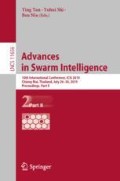Abstract
Gene expression in DNA microarrays has been widely used to determine which genes are related with a disease, identify tumors, determine a treatment for a disease, etc.; all of this based on the classification of DNA microarrays. Several pattern recognition and computational intelligence techniques such as Artificial Neural Networks (ANN) have been used to predict diseases in terms of the gene expression levels. However, to train an ANN using a reduced number of DNA microarray samples, it is necessary to apply more robust neural models due to the samples are composed of an enormous quantity of genes. In this paper, we described how a spiking neural model can be applied to solve a DNA microarrays classification task. The proposed methodology selects the most relevant genes that are related with a particular disease by means of the artificial bee colony algorithm. After that, the selected genes are used to train a spiking neural model (SNM) using a learning approach based on the particle swarm optimization algorithm. Finally, to asses the accuracy of the proposed methodology, a DNA microarrays dataset related to identify leukemia was used. The experimental results obtained with the proposed methodology are compared against those obtained with traditional distance classifier, feedforward neural networks and support vector machines. The results suggest that SNM provides acceptable results and comparable with those obtained with classical neural networks.
Access this chapter
Tax calculation will be finalised at checkout
Purchases are for personal use only
References
Huynh, H.T., Kim, J.J., Won, Y.: Classification study on DNA micro array with feed forward neural network trained by singular value decomposition. Int. J. Bio- Sci. Bio- Technol. 1(1), 17–24 (2009)
Peterson, L., et al.: Artificial neural network analysis of DNA microarray-based prostate cancer recurrence. In: Proceedings of the 2005 IEEE Symposium on Computational Intelligence in Bioinformatics and Computational Biology, 2005. CIBCB 2005, pp. 1–8, November 2005
Lancashire, L.J., Lemetre, C., Ball, G.R.: An introduction to artificial neural networks in bioinformatics-application to complex microarray and mass spectrometry datasets in cancer studies. Briefings Bioinform. 10(3), 315–329 (2009)
Khan, J., et al.: Classification and diagnostic prediction of cancers using gene expression profiling and artificial neural networks. Nat. Med. 7(6), 673–679 (2001)
Garro, B.A., Rodriguez, K., Vazquez, R.A.: Classification of DNA microarrays using artificial neural networks and ABC algorithm. Appl. Soft Comput. 38, 548–560 (2016)
Garro, B.A., Sossa, H., Vázquez, R.A.: Evolving neural networks: a comparison between differential evolution and particle swarm optimization. In: Tan, Y., Shi, Y., Chai, Y., Wang, G. (eds.) ICSI 2011. LNCS, vol. 6728, pp. 447–454. Springer, Heidelberg (2011). https://doi.org/10.1007/978-3-642-21515-5_53
Maass, W., Graz, T.U.: Networks of spiking neurons: the third generation of neural network models. Neural Networks 10, 1659–1671 (1997)
Schuman, C.D., et al.: A survey of neuromorphic computing and neural networks in hardware. CoRR abs/1705.06963 (2017)
Hasselmo, M.E., Bodelón, C., Wyble, B.P.: A proposed function for hippocampal theta rhythm: separate phases of encoding and retrieval enhance reversal of prior learning. Neural Comput. 14, 793–817 (2002)
Thorpe, S.J., Guyonneau, R., Guilbaud, N., Allegraud, J.M., VanRullen, R.: Spikenet: real-time visual processing with one spike per neuron. Neurocomputing 58–60, 857–864 (2004). Computational Neuroscience: Trends in Research 2004
Vazquez, R.A., Garro, B.A.: Training spiking neural models using artificial bee colony. Comput. Intell. Neurosci. 2015 (2015). Article ID 947098
Cachón, A., Vazquez, R.A.: Tuning the parameters of an integrate and fire neuron via a genetic algorithm for solving pattern recognition problems. Neurocomputing 148, 187–197 (2015)
Wade, J., Mcdaid, L., Santos, J., Sayers, H.: Swat: a spiking neural network training algorithm for classification problems. IEEE Trans. Neural Networks 21(11), 1817–1830 (2010)
Kasabov, N.: Evolving spiking neural networks for spatio-and spectro-temporal pattern recognition. In: 2012 6th IEEE International Conference Intelligent Systems (IS), pp. 27–32 (2012)
Hodgkin, A.L.: The local electric changes associated with repetitive action in a non-medullated axon. J. Physiol. 107(2), 165–181 (1948)
Abbott, L.: Lapicque’s introduction of the integrate-and-fire model neuron (1907). Brain Res. Bull. 50(56), 303–304 (1999)
Izhikevich, E.M.: Dynamical Systems in Neuroscience: The Geometry of Excitability and Bursting. Computational Neuroscience. MIT Press, Cambridge (2007)
Vázquez, R.A., Garro, B.A.: Training spiking neurons by means of particle swarm optimization. In: Tan, Y., Shi, Y., Chai, Y., Wang, G. (eds.) ICSI 2011. LNCS, vol. 6728, pp. 242–249. Springer, Heidelberg (2011). https://doi.org/10.1007/978-3-642-21515-5_29
Garro, B.A., Vazquez, R.A.: Designing artificial neural networks using particle swarm optimization algorithms. Comput. Intell. Neurosci. 2015 (2015). Article ID 369298
Eberhart, R.C., Shi, Y., Kennedy, J.: Swarm Intelligence (The Morgan Kaufmann Series in Evolutionary Computation), 1st edn. Morgan Kaufmann, San Francisco (2001)
Karaboga, D.: An idea based on honey bee swarm for numerical optimization. Technical report, Computer Engineering Department, Engineering Faculty, Erciyes University (2005)
Golub, T.R., et al.: Molecular classification of cancer: class discovery and class prediction by gene expression monitoring. Science 286(5439), 531–537 (1999)
Sahu, B., Mishra, D.: A novel feature selection algorithm using particle swarm optimization for cancer microarray data. Procedia Eng. 38, 27–31 (2012). International Conference on Modelling Optimization and Computing
Wang, A., An, N., Chen, G., Li, L., Alterovitz, G.: Improving PLSRFE based gene selection for microarray data classification. Comput. Biol. Med. 62, 14–24 (2015)
Alshamlan, H.M., Badr, G.H., Alohali, Y.A.: Genetic bee colony (GBC) algorithm: a new gene selection method for microarray cancer classification. Comput. Biol. Chem. 56, 49–60 (2015)
Acknowledgment
The authors would like to thank Universidad La Salle México for the economic support under grant number NEC-10/18.
Author information
Authors and Affiliations
Corresponding author
Editor information
Editors and Affiliations
Rights and permissions
Copyright information
© 2019 Springer Nature Switzerland AG
About this paper
Cite this paper
Vazquez, R.A., Garro, B.A. (2019). Spiking Neural Models and Their Application in DNA Microarrays Classification. In: Tan, Y., Shi, Y., Niu, B. (eds) Advances in Swarm Intelligence. ICSI 2019. Lecture Notes in Computer Science(), vol 11656. Springer, Cham. https://doi.org/10.1007/978-3-030-26354-6_16
Download citation
DOI: https://doi.org/10.1007/978-3-030-26354-6_16
Published:
Publisher Name: Springer, Cham
Print ISBN: 978-3-030-26353-9
Online ISBN: 978-3-030-26354-6
eBook Packages: Computer ScienceComputer Science (R0)

